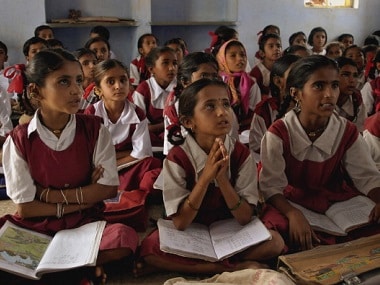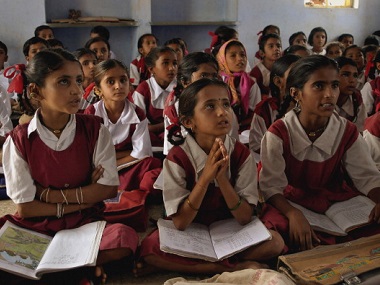Editor’s note: The draft New Education Policy, which intends to introduce broad reforms, is now open for public scrutiny. In this three-part series , Firstpost examines the structural efficacy of the proposed policy. This is the second part of the series. The New Education Policy is quite promising. It promises marriage to the bachelors and divorce to the married. It is particularly true with regard to its position when it comes to private schools’ social obligation towards society. On one hand, it laments that private schools, over the last five decades, have become less diverse in student socioeconomic profile than before. It then goes on to recommend that this worrying trend, “must be reversed” as it “harmfully stratifies the school system and access to it”. Marriage for the bachelors promised. [caption id=“attachment_4397529” align=“alignleft” width=“380”]  Representational image. Getty Images[/caption] Yet, the policy blames the only provision capable of reversing the trend, section 12(1) (c) of Right to Education (RTE) Act that mandates all the private schools to admit 25 percent of children from economically weaker section (EWS) and socially disadvantaged groups (DG) in its lowest entry class. The policy says, “In the end, the [private] schools must decide that they want this [diversity of children]; forcing schools through measures such as those in the RTE Act 12(1)(c) have not worked nearly as effectively as had been hoped. Giving schools the autonomy to do the right thing, and to innovate, is in general the better way to encourage best practices in schools” and then goes on to recommend a review of the provision itself. Divorce to those married promised too. This is a polite warning of initiation of the process that may eventually lead to a repeal of the provision. The policy provides an opportunity for serious reflection and in-depth examination of our current practices. To that effect, the status of implementation of RTE Section 12(1)(c) [EWS/DG Quota] and how the facts and evidence have been brushed aside, conveniently, by the committee that drafted the New Education Policy will be examined. Here are a few facts for the committee to ponder over and it’s pertinent that the country knows if these points were taken into account while formulating the policy. FACT 1: As per the response submitted by the Ministry of Human Resource and Development (MHRD) to a parliamentary question, five states have not even issued notification required to commence admissions. The states are Goa, Manipur, Mizoram, Telangana, and Sikkim. In the light of flagrant violation by these five states nearly a decade since the law was passed, did the committee not find it appropriate to call out the government’s lack of commitment to take the first basic step towards the implementation of the provision? Was it oblivious to the facts? How does its stance of “RTE Act 12(1)(c) have not worked nearly as effectively as had been hoped” withstand basic scrutiny in these five states? FACT 2: As per the same statement submitted by the minister, 11 states have self-reported that the no admissions have not commenced in these states, effectively admitting that the provision is not being followed. These states are Andhra Pradesh, Arunachal Pradesh, Haryana, Himachal Pradesh, Kerala, Nagaland, Punjab, Tripura, West Bengal, Puducherry and Meghalaya. With 11 states reporting, illegally, that the admissions have not commenced, the statement that having worked “measures such as those in the RTE Act 12(1)(c) have not worked as effectively as had been hoped” is a work of fiction as it has not been given a chance by the governments of these states. FACT 3: For the past several years, Delhi and Rajasthan have shown that it is possible to implement the provision with high fill rates and schools’ participation rates. Both states have effectively used technology to streamline its admission process and build effective tracking tools. Did the committee not study these two states to draw inferences different from the one it did, erroneously? How does the committee view two states being able to implement and others not? Is the committee aware that the state of Maharashtra, Gujarat and Chhattisgarh are beginning to do well too? FACT 4: Several studies establish that diverse classrooms allow for better students’ academic achievement, more empathetic approach and friendships that transcend caste, class, gender and sexuality. In a paper titled, Familiarity Does Not Breed Contempt Gautam Rao from Harvard University has demonstrated that the EWS/DG Quota is a very effective instrument at positively influencing the behaviour and attitude from children from advantaged backgrounds. Has the committee proposed an alternative means for making private schools inclusive despite calling it a worrying trend? The response would come as a disappointment to those who painstakingly fought to make schools inclusive spaces and those who have the passion for it. FACT 5: The Supreme Court in Society of Unaided Schools of Rajasthan Vs. Government of India upheld the constitutional validity of section 12(1)(c) of the Right to Education Act despite it being fiercely opposed by the private schools on the ground that it curtails their autonomy. What is the rationale the committee puts forth for advancing the same argument that has already been examined by the Supreme Court and rejected comprehensively? FACT 6: The private schools have become more exclusionary and less diverse, by the very admission of the committee. Clearly, the private schools had the choice to not go down that route if they did not wish to for it could always carve out a fraction of its students from economically and socially weaker sections. Primarily, they did not. How does the Committee explain its recommendation to “trust them to do the right thing” when they have not done so for five decades? What incentives has it proposed to change such a long-held notion? FACT 7: Among many concerns with regard to implementation of the clause, the committee cites “manufacturing of fake certificates, increases in fees” as the primary ones. Assuming that all public policies must be rooted in a serious examination, what was the data set the committee examined in order to come to its two conclusions of “fake certificates” and “increase in fee”? They appear to be rooted in the famous film which like the committee members, I too enjoyed. This is not to say that the concerns are not legitimate because they are. Such concerns call for safeguards. If corrupt practices could be cited as grounds for abolition of the legislative provision for children, this could very well make a sound ground for abolition of the very concept of the governments! Delhi Commission For Protection of Child Rights (DCPCR), Government of Delhi commissioned a research study in collaboration with Indus Action, a non-profit working in Right to Education implementation space, and examined several of the concerns pointed out by New Education Policy. One finding was clear, that the challenges highlighted by the committee are surmountable and are likely to yield dividends across educational and social indicators. The Delhi government has recently instituted the Social Inclusion Award for schools that effectively integrate the children admitted under the provision. The Child Rights Commission is in the process of documenting best practices for their wider dissemination and capacity building. Effective grievance resolution mechanisms, students’ attendance and performance tracking systems and reimbursements hold the key to effective implementation. A retention survey conducted by Indus Action shows 83 percent of students admitted over the last three years in Delhi are still studying in the schools. All this indicates that schools can be inclusive if the governments put money where their mouth is. To be fair to the committee, it did recommend sound measures for streamlining admission process by leveraging technology and strong student tracking systems. They appear to be, however, half-hearted and last resort. **Part 1: New Education Policy: Non-inclusion of teachers in core committee deprived panel knowledge of on-ground challenges** **Part 3: New Educational Policy fails children with special needs, misses chance to make mental health screening mandatory** The author works as a Secretary-rank officer in Delhi Commission For Protection of Child Rights (DCPCR), Government of Delhi. Views expressed are personal.
A retention survey conducted by Indus Action shows 83 percent of students admitted over the last three years in Delhi government schools are still studying in the schools.
Advertisement
End of Article


)

)
)
)
)
)
)
)
)



